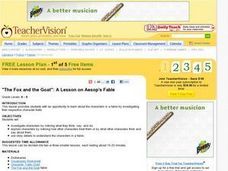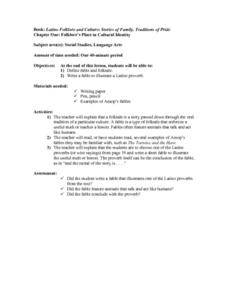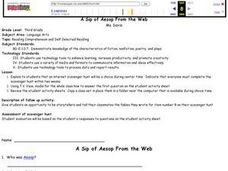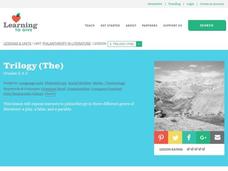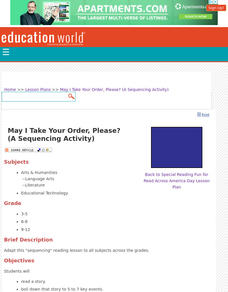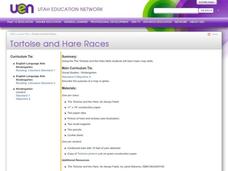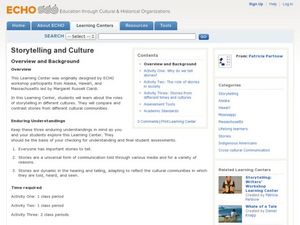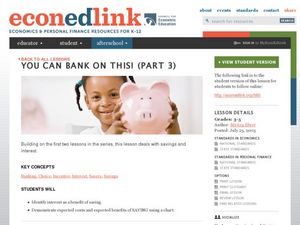Overcoming Obstacles
Being Responsible
Responsible-decision making is the focus of the social-emotional learning lessons. After reading, The Ant and the Grasshopper: An Aesop Fable, scholars come up with six steps to take responsibility for their actions and then practice the...
Curated OER
Slow and Steady Wins the Race
Students are introduced to the characteristics of fables. They read a fable by Aesop. In small groups, students identify fable characteristics present in Aesop's story and share their observations with the class.
Curated OER
The Fox and the Goat
Students investigate characters' traits in a specific fable by noticing what they think, say, and do. They study key vocabulary and complete a vocabulary worksheet. They work in groups to discuss how you know if a person is kind.
Curated OER
Latino Folklore and Culture: Stories of Family, Traditions of Pride
Students define the terms fable and folktale. They write a fable to illustrate a Latino proverb. Students are explained that a folktale is a story passed down through the oral tradition of a particular culture. A fable is a type of...
Curated OER
The Lion and the Mouse
Learners write a story. For this critical thinking and writing lesson, students read a fable, answer the provided thinking skills questions, and write their own fable.
Curated OER
A Sip of Aesop From the Web
Third graders answer specific questions by conducting an Internet scavenger hunt. They write their own fable after reading many different fables on the Internet. They questions that they answer are included in this lesson.
Curated OER
Folktales: Fables
Learners access a variety of resources on the Internet regarding folktales, fables, tall tales, and fairy tales. They read and compare/contrast the elements of fables, and complete various handouts.
Curated OER
Technology-commected Folklife Lesson Plan: Fables
Learners discuss ways the stories were alike and different. The teacher demonstrate how to draw a Venn diagram using Microsoft Word. They label the two circles and enter the likenesses and differences on the diagram.
Curated OER
Drama: Learn A Lesson from the Lion
Reading is reading, whether it's for drama or English class. Boost reading fluency, accuracy, intonation, and comprehension while fostering creative acting skills. Kids read the provided tale of "The Lion and the Mouse" several times in...
Curated OER
Tortoise and Hare Races
Students listen to the fable, The Tortoise and the Hare, and participate in various map skill activities. They manipulate magnetic tortoises and hares on metal cookie sheets to practice direction, and construct racing tortoises out of...
Curated OER
What is a Philanthropist?
What does a philanthropist do? Help your class explore philanthropy using character development and literacy ideas. Learners will define and give examples of philanthropy, listen to The Lion and the Mouse, discuss how the characters help...
Curated OER
Identifying the Theme in a Story
Middle schoolers recognize Theme through the use of simple, short stories. Using Pro Quest, students begin by researching the literary element, theme, and how it can be identified. They then identify the themes in Aesop's...
Curated OER
Writing Fables
Students develop a working skill of using graphic organizers for writing. The instructional activity notes that the best kind of organizer is one that is engaging to the appropriate audience. The assessment follows the rubric given in...
Curated OER
Philanthropy in Literature
Students research philanthropy in three genres: a play, a fable, and a parable. Students read an Aesop fable and answer questions in groups. Students complete steps in two worksheets from 'The Good San Franciscan' and 'Someone Should.'...
Curated OER
Animal Tales Around the World
Students explore characteristics of Indian Tales/ Parables. In this literature lesson, students compare contemporary society to western culture through analysis. Students create their own tales using this genre.
Curated OER
J. Paul Getty Museum Education Staff
Students will examine a manuscript page from a Flemish bestiary and discuss how it was used to teach ideas about Christianity. In this Christianity lesson plan students study the given manuscript and then compare the stories from the...
School Specialty
The Tortoise and the Hare - Drawing Conclusions/Predictions Outcomes
Does the fastest one always win the race? Look deeper into The Tortoise and the Hare with a set of discussion questions for before, during, and after reading the story.
Curated OER
May I Take Your Order, Please?
Pupils read a story, boil down that story to 5 to 7 key events, create a sequencing quiz to go with the story and have their classmates take the quiz. They will the strategy of sequencing by reading various stories (that they are not...
Curated OER
Helpful Animals and Compassionate Humans in Folklore
Students define elements of stories from around the world that include helpful animals. They explore animal character motivations and use graphic organizers to compare and contrast animal stories from different cultures.
Curated OER
Tortoise and Hare Races
Practice basic map skills with the story of The Tortoise and the Hare. After listening to the story, class members create a map that indicates the starting line, the path the animals took, where they stopped to rest, and the finish line....
Curated OER
Storytelling and Culture
Students examine the cultural tradition of storytelling. In this storytelling lesson, students explore stories from 3 different cultures and evaluate the roles that storytelling plays in each of the cultures to pass on values and beliefs.
Curated OER
Who's Got Game? The Lion or the Mouse?
Discuss bullying, folk tales, and more using this resource. Learners read the story The Lion and the Mouse by Toni and Slade Morrison, engage in cause and effect activities, make predictions, and discuss bullying. This is a motivating...
Curated OER
Forecast Sunny and Warm
Students explore the concept of philanthropy. In this service learning lesson, students participate in hands-on activities that replicate building a foundation and providing for future generations.
Council for Economic Education
You Can Bank On This! (Part 3)
Young scholars use a chart to show how gaining interest is a beneficial part of having a savings account. In this banking lesson plan, students also learn about the workings of an ATM and a checking account.
Other popular searches
- Aesop's Fables 3rd Grade
- Aesop's Fables Videos
- Aesop's Fables Activities
- Aesop's Fables Worksheets
- Aesop's Fables Unit
- Aesops Fables Unit
- Aesops Fables Powerpoint
- Aesop's Fables Lesson Plans
- Aesop's Fables Plays
- Aesops Fables Comparison
- Aesop's Fables Literacy
- Aesops Fables Literacy




